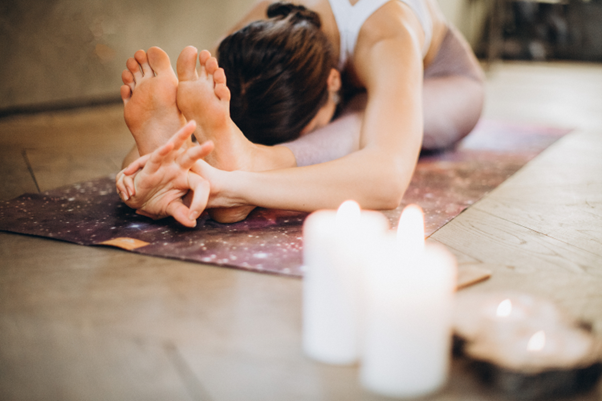What you need to know about practicing yoga during phase one of your menstrual cycle.
Alongside the myths around inversions and twists, practicing on our periods attracts a few more myths, warnings, and words of caution. To our benefit, modern science is rapidly dispelling myths and laying a foundation for us to make informed decisions about what is good for us in any given moment. And this is important to remember. After all, yoga is about focusing on what is happening now, and listening to what the dictates of your heart are saying. Once we tune into that dialogue with ourselves, we can cultivate our practice to profoundly benefit our health. This month, we discuss a few more of the myths surrounding female health in the yoga space, and what tweaks you can make to your practice to optimise your health – however you’re feeling.
If you’re tired, you should practice hard.
This is based on the theory that using energy creates energy. Yes, to an extent. With a caveat that while you are mid-menses, fatigue can be all encompassing and difficult to shift. Conscious awareness of how the physical body is feeling should be honoured during this time. You may have abundant energy on some days, and utter exhaustion on others. And that’s ok. Be a witness to the physical self and honour those tired days with a more dedicated, purposeful practice that works to serve an intention or mindfulness practice. Focus on pranayama exercises. Sama vritti pranayama is my personal favourite for achieving the same meditative state that a physical yoga practice can bring.
If you are lacking energy but still want to take a physical practice, Yin yoga-based sequences will help to restore the body. Yin yoga prescribes a number of poses that are held for up to 5 minutes. They include Pigeon pose (Eka Pada Rajakapotanasana) and Dragonfly posture. The intention of Yin yoga is to deepen physical ability through elongated postures and achieve a deeper meditative function. By working deep into the body’s tissues, we release tension and trapped emotions, achieving a more peaceful, restful state.
And, when you have more energy, you might find that your more active practices have a deeper meaning, and you flow through with more purpose and intention.

Yoga can help you get your period
No, unfortunately not. Yoga can’t influence biology, so it will come when it comes. And, if it doesn’t, that’s nothing to do with your yoga practice itself, but could be due to pregnancy or another underlying health condition. There are no miracle postures or flows that will initiate your flow. Previous postulations that prone postures (lying on the abdomen) and back bends can increase pressure and blood flow to the pelvic area simply aren’t tangible. There’s no evidence to suggest that this influences the period bleed to start. What yoga can do is provide you with a wellbeing system that encourages you to move your body and manage stress levels through pranayama and conscious awareness.
Combining low intensity stretching with some more active, cardiovascular flows, and weight-bearing exercises for strength and tone contribute to positive mental and physical health outcomes. Ashtanga and Vinyasa type sequences can provide fantastic cardiovascular workouts, whilst Hatha can provide the benefits of weight bearing exercises. Try a few rounds of Sun Salutation A & B (Surya Namaskar A & B) for combined cardio and strength work. Weight bearing postures like Chair (Utkatasana), Plank (Phalakasana) and Dolphin (Ardha Pincha Mayurasana) reap massive rewards for overall muscle health and increased bone density.
A regular yoga practice can also provide a practice for restoration and mindfulness, all of which are crucial pillars to building good health. And a regular period is a key indicator of good health. If you are concerned about erratic or missing periods, speak to your GP.
You’re more flexible during your period
For most of us yes, we most likely will be! There is evidence to suggest we have more elasticity in our tissues and around the joints (known as ligamentous laxity) at this time. Our periods might also reduce stretch reflex sensitivity and affect our general motor control, resulting in a more flexible body. However, treat this with the caveat that you should still stay within a comfortable range of motion, so as not to risk overstretching muscles, tendons, or ligaments.
If you are feeling more like a rubber band, you might want to take this time to explore more Yin-based postures or progressing on the foundations you might have already built in your general yoga practice. Moving through Pyramid pose (Parsvottonasana) to Monkey posture Hanumanasana), or Pigeon pose (Eka Pada Rajakopatasana) to Mermaid posture are great examples of yin based challenges that can help you explore your body whilst you’re a bit more bendy!

Science is an amazing factual moderator, but there is still so much to discover about female health. Your body is your best guide when it comes to your period. If you listen closely enough, it will tell you what it needs. Whether that’s running 5k to burn off stress, or spending a day on the sofa, honour those messages. Society pressures us in to constantly achieving and staying in a hyper-stressed state so we don’t miss out – when really all we want to do is eat chocolate and watch Gilmore Girls. And that’s ok. The hardest part of yoga for most students is self-realisation and giving in to what we really want – regardless of what we think we might miss out on. But, by “missing out” on other things, you might gain a lot of insight into yourself.



